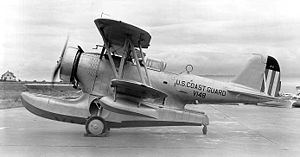| This article needs additional citations for verification. Please help improve this article by adding citations to reliable sources. Unsourced material may be challenged and removed. Find sources: "Grumman JF Duck" – news · newspapers · books · scholar · JSTOR (January 2015) (Learn how and when to remove this message) |
| JF Duck | |
|---|---|
 Grumman JF-2 Duck in United States Coast Guard service Grumman JF-2 Duck in United States Coast Guard service | |
| General information | |
| Type | Utility amphibian |
| National origin | United States |
| Manufacturer | Grumman |
| Primary users | United States Navy United States Marine Corps Argentine Navy United States Coast Guard |
| Number built | 48 |
| History | |
| Introduction date | 1935 |
| First flight | 24 April 1933 |
| Variants | Grumman J2F Duck |
The Grumman JF "Duck" was an American single-engine amphibious biplane built by Grumman for the United States Navy during the 1930s. The J2F Duck was an improved version of the JF, with its main difference being a longer float.
Design and development
The Grumman JF Duck was manufactured from 1934 until 1936, when production switched to the J2F Duck and later variants. The more obvious external appearance clue to distinguish a JF from an early J2F is the deletion of the inter-aileron strut between the wings on the J2F; less noticeable perhaps is the J2F's slightly longer rear fuselage/float joining fillet beneath the tail.
The Duck's main pontoon was part of the fuselage, almost making it a flying boat, although it appears more like a standard aircraft with an added float. The XJF-1 prototype first flew on 24 April 1933 piloted by Grumman test pilot Paul Hovgard.
Operational history
| This section needs expansion. You can help by adding to it. (April 2017) |
The JF-1 that was first ordered had the same Pratt & Whitney R-1830-62 engine as the XJF-1 prototype. The US Navy ordered 27 JF-1s with the first Ducks delivered beginning in May 1934 to Norfolk NAS. These early production series had provisions for mounting a machine gun at the rear seat facing aft, as well as a single bomb rack mounted under each wing, capable of carrying a 100 lb (45.4 kg) bomb or depth charge on each. The main float was also a Grumman design (Grumman Model "A") and like the prototype, it included retractable main landing gear, making the Duck a true amphibian. Ducks served as general/utility amphibians for photographic, target-towing, scouting, and rescue work.
Variants
- XJF-1
- Prototype with 700 hp Pratt & Whitney R-1535-62 engine, one built (BuNo 9218).

- JF-1
- Production variant with 700 hp Pratt & Whitney R-1830-62 Twin Wasp engine, 27 built (BuNos 9434-9455, 9523-9527).
- JF-2
- Variant for the United States Coast Guard powered by a 750 hp Wright R-1820-102 Cyclone engine, 15 built (BuNo 0266, 00371-00372, 01647, USCG V141-V155).
- JF-3
- JF-2 for the U.S. Navy, five built (BuNos 9835-9839).
- Grumman G-20
- Armed version of the Grumman JF-2 for export to Argentina. Eight built.
Operators
- Argentine Navy – Operated eight G-20s.
- United States Navy
- United States Coast Guard
- United States Marine Corps – Operated one JF-2
Specifications (JF-2)
Data from
General characteristics
- Crew: 2–4
- Length: 33 ft 0 in (10.06 m)
- Wingspan: 39 ft 0 in (11.89 m)
- Height: 12 ft 8 in (3.86 m)
- Wing area: 409.0 sq ft (38.00 m)
- Empty weight: 4,100 lb (1,860 kg)
- Gross weight: 5,760 lb (2,613 kg)
- Fuel capacity: 150 US gal (120 imp gal; 570 L)
- Powerplant: 1 × Pratt & Whitney R-1830 Twin Wasp 14-cyl two row air-cooled radial piston engine, 775 hp (578 kW)
Performance
- Maximum speed: 185 mph (298 km/h, 161 kn) at 7,000 ft (2,100 m)
- Cruise speed: 155 mph (249 km/h, 135 kn)
- Stall speed: 63 mph (101 km/h, 55 kn)
- Range: 620 mi (1,000 km, 540 nmi)
- Service ceiling: 22,000 ft (6,700 m)
- Rate of climb: 1,600 ft/min (8.1 m/s)
See also
Related development
Aircraft of comparable role, configuration, and era
References
Notes
- Allen 1983, p. 49.
- ^ Jordan, Corey C. "Grumman's Ascendency: Chapter Two." Archived 2012-03-25 at the Wayback Machine Planes and Pilots Of World War Two, 2000. Retrieved: 22 July 2011.
- Thruelson 'The Grumman Story' 1976, p. 77.
- Allen Air Enthusiast Twenty-three, p.78.
- Allen Air Enthusiast Twenty-three, pp. 47–48.
- Aviation April 1937, pp. 70–71
Bibliography
- Allen, Francis J. "A Duck Without Feathers". Air Enthusiast, Issue 23, December 1983 – March 1984, pp. 46–55, 77–78. Bromley, Kent UK: Pilot Press, 1983.
- "Specifications of American Airplanes". Aviation, Volume 36, No. 4, April 1937, pp. 66–71. (Registration required)
- Lezon, Ricardo Martin & Stitt, Robert M. (January–February 2004). "Eyes of the Fleet: Seaplanes in Argentine Navy Service, Part 2". Air Enthusiast (109): 46–59. ISSN 0143-5450.
- Thruelsen, Richard. The Grumman Story. New York: Praeger Publishers, Inc., 1976. ISBN 0-275-54260-2.
- Treadwell, Terry. Ironworks: Grumman's Fighting Aeroplanes. Shrewsbury, UK: Airlife Publishers, 1990. ISBN 1-85310-070-6.
Further reading
- Ginter, Steve (2009). Grumman JF/J2F Duck. Naval Fighters. Vol. Nº84 (First ed.). California, United States: Ginter Books. ISBN 978-0-942612-84-4. Retrieved 31 January 2015.
- Nuñez Padin, Jorge Félix (2002). Grumman G.15, G.20 & J2F Duck. Serie Aeronaval (in Spanish). Vol. Nº15. Buenos Aires, Argentina: Museo de la Aviación Naval, Instituto Naval.
External links
| USN/USMC utility aircraft designations 1935–1962 | |||||||||||||||||||||||||||||||
|---|---|---|---|---|---|---|---|---|---|---|---|---|---|---|---|---|---|---|---|---|---|---|---|---|---|---|---|---|---|---|---|
| Utility (J) (1935–1955) |
| ||||||||||||||||||||||||||||||
| Utility transport (JR) |
| ||||||||||||||||||||||||||||||
| Utility (U) (1955–1962) |
| ||||||||||||||||||||||||||||||